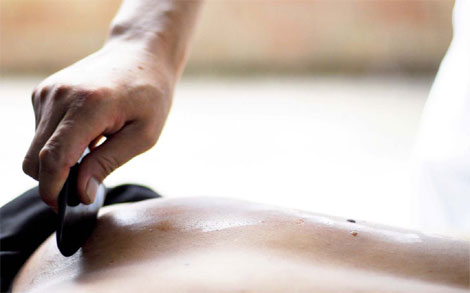
A patient undergoes gua sha treatment, one of the oldest recorded forms of traditional Chinese medicine treatments. [Wu Pengfei / For China Daily]
Ancient Chinese medical treatment leaves lasting impressions
Renata Nunziante teaches Italian in Beijing. Lately, because of a hectic work schedule, her shoulder has been feeling heavy, with occasional aches.
"The doctor diagnosed it as early scapulohumeral periarthritis. Taking Western analgesics didn't help. One of my Chinese students suggested that I try gua sha treatment," the middle-aged woman says.
"After a slim tool was used to repeatedly scrape my skin in one direction, my physician told me many purplish spots appeared on the area involved.
"My symptoms were obviously alleviated after undergoing a course of therapy."
The Italian teacher is among an increasing number of patients and physicians at home and abroad who are promoting the benefits of gua sha, one of the oldest recorded forms of traditional Chinese medicine (TCM) treatments.
Gua sha, meaning to "scrape away illness", involves using tools such as bian stone, jade, or ox horn with lubricant liniment to scrape and rub parts of the patient's skin repeatedly in one direction. The aim is to "activate blood circulation to dissipate blood stasis", based on TCM theory.
Historical records on gua sha go back to the Paleolithic Age. When people fell sick or became unconscious, hands or stones were used to rub parts of their body to help alleviate the symptoms of disease.
Gua sha has long been a folk therapy widely used by the ancient Chinese. In the Ming Dynasty (1368-1644), the treatment was systematically written into major medical records.
The use of stones to scrape the skin and treat diseases has been gradually improved throughout the ages, in line with TCM practices.
In 2001, a Chinese movie on gua sha and the Chinese cultural connotations attached to the treatment was released. Gua Sha or The Treatment, starring the Hong Kong actor Tony Leung Ka-Fai, was about cultural conflict in a Chinese family in the United States, in particular a misunderstanding about gua sha.
In the film, a grandfather could not make out medical instructions in English, so he uses traditional Chinese therapy to cure his grandson. The old man leaves scrape marks on the child's back after using gua sha to treat the child's fever, and is later accused of child abuse.
"Gua sha is a completely safe technique," says Max Jonuscheit, a German who has studied traditional Chinese medicine in China for four years. "In Chinese, gua means to scrape or rub, sha is a kind of reddish millet-like petechiae. Sha is the term used to describe blood stasis in the subcutaneous tissue as petechiae. Gua sha is a treatment that intentionally raises the rash or petechiae.
